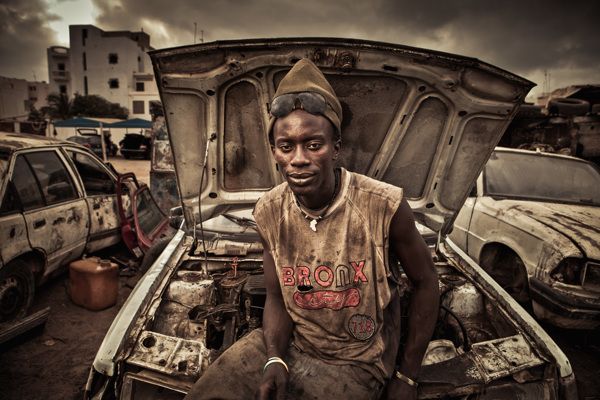
Technical: Here natural lighting has been used as this image has been taken outside, this allows the texture of the clouds not to be lost as everything can be clearly seen. The position of the camera has been placed parallel to the the man in the image. The focal point is clearly on the man as he has the most focused part in the image, however the cars in the background are still shown allowing the audience to see a “bigger image” of what the man works with. The white balance is is just leaning on the cold side which is shown as the warmer tones t=in the images such as his yellow and red shirt is hardly shown, which allows the audience to focus on the dirt and the blue roofs of the buildings. Here the saturation of the image has been somewhat turned down allowing the audience to focus the centre point of the image which is successful as its a environmental portrait.
Visual: The tones in the image is generally dark matching the dirt shown throughout the image, which allows the audience to see the true reality of the working environment in which the man is living in, here he doesn’t try and sugar coat the image but simply presents his environment how it is. Again the element of dirt gives texture to the image, showing that he doesn’t work in a nice mordernised mechanics office that many people in the “first world” are used to. The pattern of the cars is present suggesting that he needs to work through many cars each day in order to make the amount of money that he needs to survive. The shape of the image is 3D due to the different depths in the image with the main cars shown at the foreground and then the buildings shown in the background. Here the Rule of Thirds is used effectively as as they eye is lead to the centre third and onto the man.
Contextual: This image was part of a a selection of images that Anthony Kurtz took in Senegal. Here he joined as a volunteer in a high school-lead trip where he did community work. Here most the images were taken in the village of Dindefelo (south of Senegal). He also went to “Dakar to do more “strobist” style, street photography and worked on different personal projects.” Anthony talks about the connection he created with the people he photographed as many people turned him down however he kept asking people and ” made sure people in Dindefelo received copies of their portraits and I hope they enjoy looking at them” he talks about still being able to keep in touch with the people, showing the bond he grew as he didn’t just take pictures of them and then moved on but he worked with them and spoke to them to made sure they felt comfortable. (Quotes from Anthony Kurtz found on: https://www.behance.net/gallery/11984331/Part-2-Senegal-Street-Portraits-Africa )
Conceptual: I think the overriding theme to this image is the work that Anthony Kurtz has put in to approach and speak to the people he has photographed, here he spends as long period of time with these people, getting to know them as a person and their experiences. I think that this is important as Kurtz didn’t just take pictures of rich celebrities that are already in the public eye, but he wanted to show the true environments in which people live in.
